Okay, maybe not exactly.
In 1736 Johann Heinrich Callenberg, an Orientalist heavily involved in missionary work, printed a dictionary called Jüdischteutsches Wörterbüchlein (Yiddish-Teitch Dictionary) which is basically a dictionary of the Jewish and Hebrew content of the Jew's dialect of German spoken at the time, which would not have been familiar to Christians. The words and phrases are arranged in alphabetical order, according to the German meaning. Thus, there is no theme or order on the Hebrew side. The purpose of this dictionary was to enable Christians to understand Jews when they spoke amongst themselves, to understand Jewish literature written in Yiddish, and to engage Jews in their own tongue. With 148 pages of entries and an average of 26 or so per page, the lexicon includes approximately 3900 words. Following the lexicon is an alphabetical index of the Hebrew words, and a short guide to the language, including pronunciation rules.
As you can see, the Hebrew text is printed using Wayberteitch, or the special Yiddish font which survived until well into the 19th century. Thus, the text presupposes that the reader not only has a basic reading knowledge of Hebrew but already knows how to read the Wayberteitch font - which anyone who is familiar with the Rabbinic or Rashi script can read with some practice.
As you can see, the Hebrew text is printed using Wayberteitch, or the special Yiddish font which survived until well into the 19th century. Thus, the text presupposes that the reader not only has a basic reading knowledge of Hebrew but already knows how to read the Wayberteitch font - which anyone who is familiar with the Rabbinic or Rashi script can read with some practice.
The rabbinic font was not widely known to Christians, and this one all the less so. Therefore this book is hardly for a novice Hebraist. Rather, it is for someone who had already been schooled in the Alphabeto Germanico Judaeorum, perhaps by reading a book like the following:
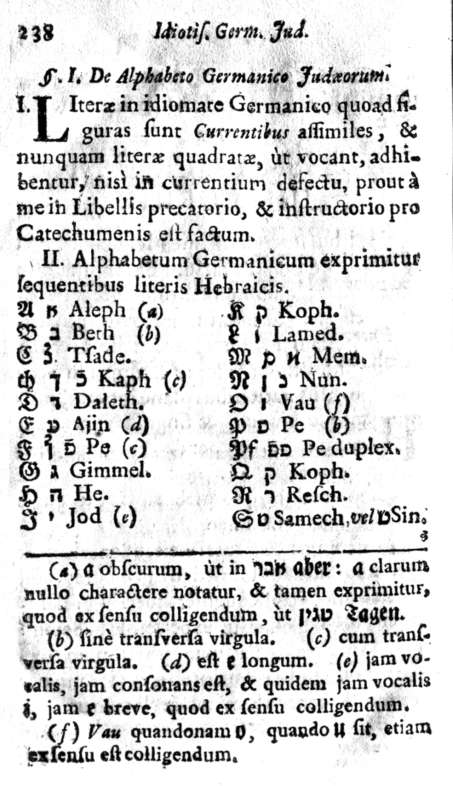
Samples: סתם which is translated as Absolute, מודה זיין על האמת, and צנוע and צניעות as well as שימוש and פסקן, and - oddly? - משכב זכר (da mann mit mann schande treibet). פרנס, which is translated as juedischer buergermeister, חוזר בתשובה זיין, which is proof that there were BTs 275 years ago (also mann mit mann schandes, but I digress). קשר הפסוקים is defined as "context," אמונה is "credit, מפלפל זיין is to Disputiren. Since, in the final analysis, this book is meant for missionary purposes, it also gives a Yiddish (actually, Hebrew) equivalent of the heilige dreyeinigskeit (holy trinity), שילוש הקדושה. In what I suppose is a cultural nod to the culinary realities of the unrefrigerated 18th century, there is also a term for dried meat, בשר יבש. These sample are from the first few pages, but there are - as I said - almost 4000 entries!
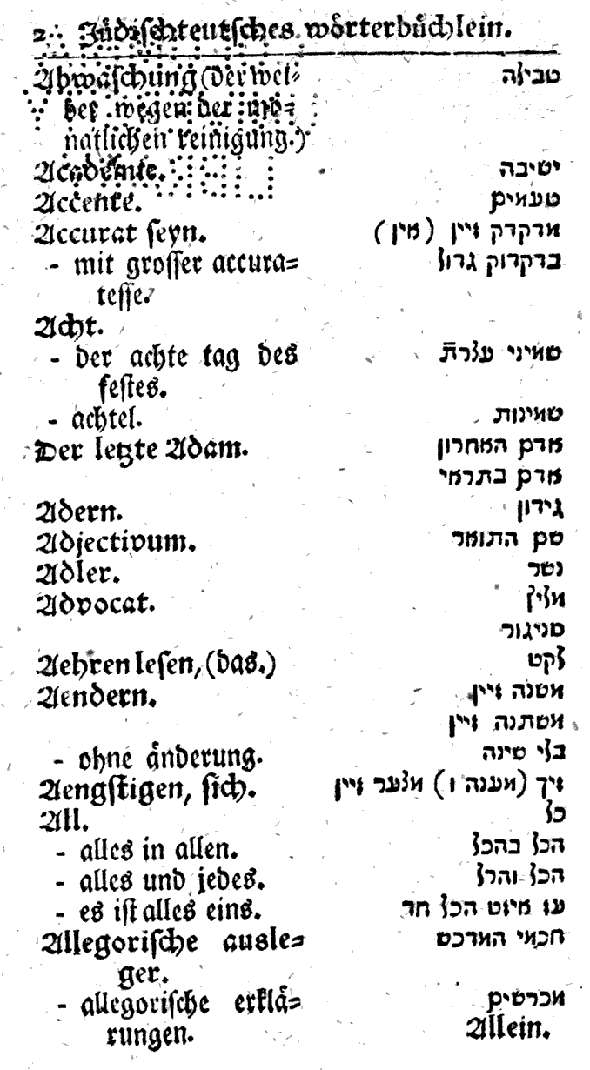


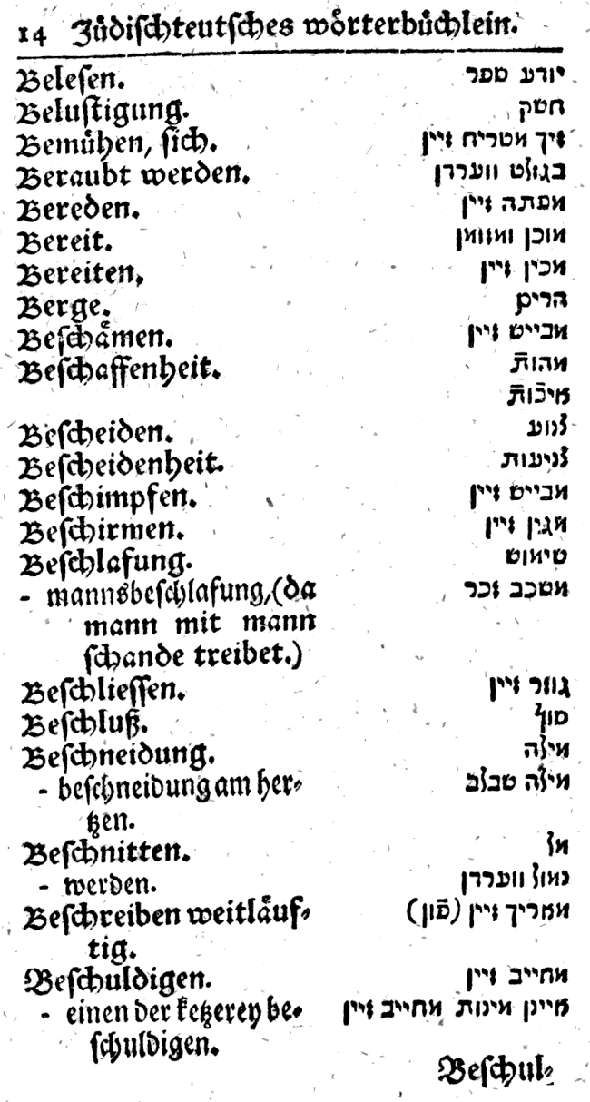
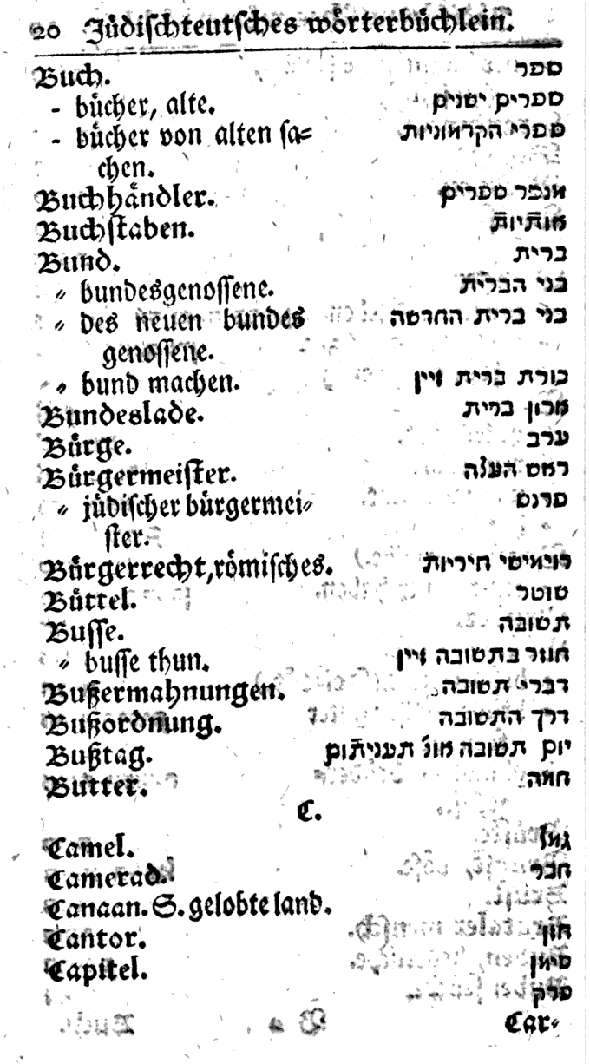
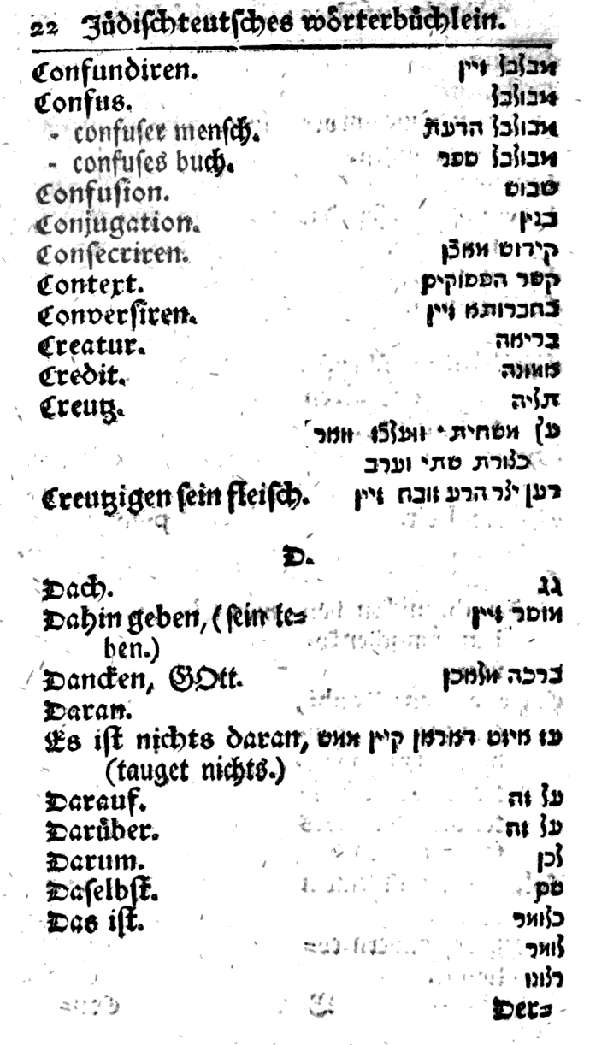
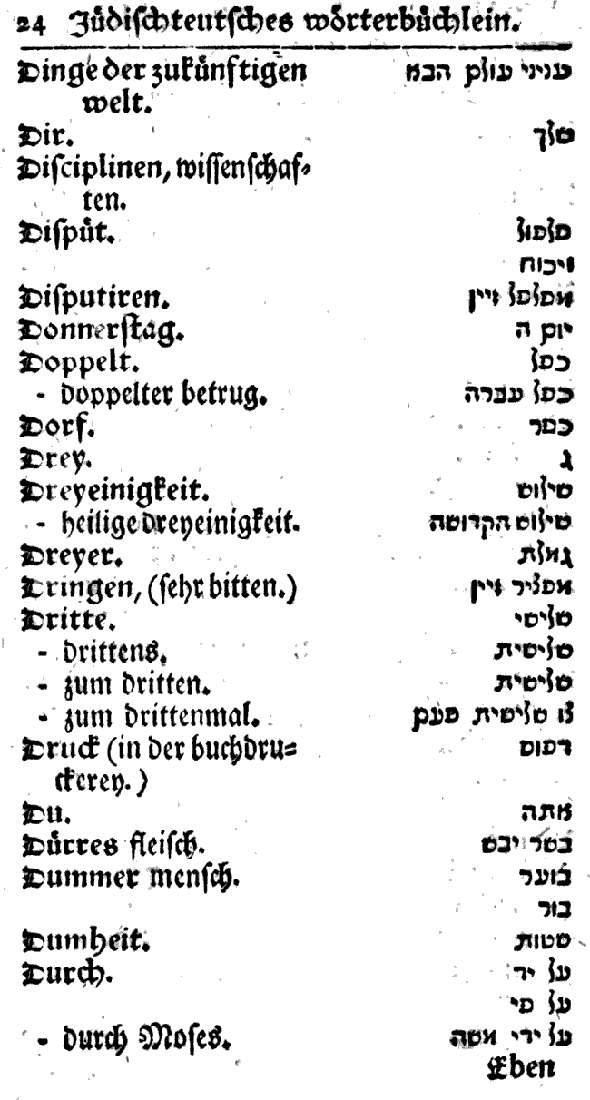
In truth it's worth looking over the whole book. In it, you will see an interesting lexicon of early 18th century Ashkenazic terminology - some no doubt assumed or invented, but much of it quite real.
See this post for an overview of a Hebrew version of Luke written as a rabbinic Bible commentary, and also published by Callenberg.

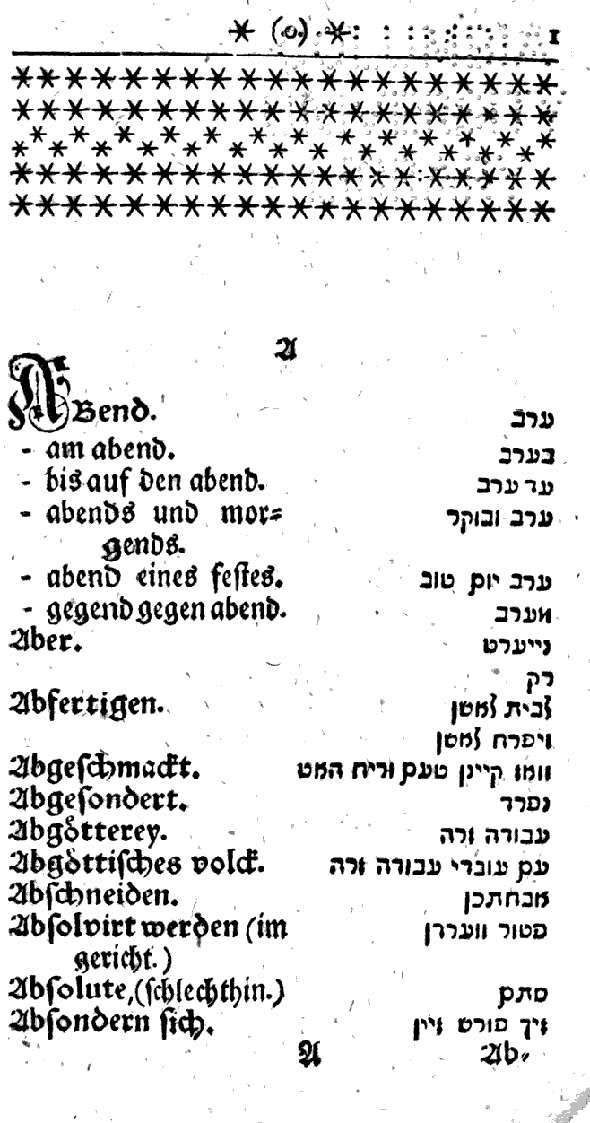




Can you expand on the topic of Wayberteitch, the Yiddishe Font. [Sounds like the name of a kids book, but I also digress.] It looks very similar to rashi script, but it has a few squiggles and things. What's the story with it?
ReplyDeleteThank you. I blog on sex abuse and regularly hear frum folks saying that they are just becoming aware of the problem because till now no one talked about these things just like they didn't talk about homosexuality. Thanks for mentioning mishkav zochor. So much for that theory.
ReplyDeleteThe purpose of this dictionary was to enable Christians to understand Jews when they spoke amongst themselves, to understand Jewish literature written in Yiddish, and to engage Jews in their own tongue.
ReplyDeleteThen wouldn't it be much more useful to arrange it in order of the Yiddish words?
Well, there is the index arranged alphabetically in Hebrew/ Yiddish.
ReplyDeletein a later age yiddish-german dictionaries were published for so germans could communicate with jewish traders
ReplyDeleteDF:
"Can you expand on the topic of Wayberteitch, the Yiddishe Font"
first extensive use was in a hebrew-yiddish dictioanry printed in cracow in the 1534. herbert zafren wrote about yiddish typefaces in JBA and HUCA in the 1980s`
Abba's rantings: I'll look up the sources you mention. Max Weinreich said Vaibertaitsh is the font, as does Fred. Dovid Katz says Vaibertaitsh refers to the Yiddish language itself. This is according to K.'s *Words on Fire*; the book has some annoying stuff, but he's a formidable scholar on Yiddish. I'm not taking the word of anyone who has an opinion nowadays on what the word means, since they might have gotten the info from either Weinreich or Katz. If Zafren tells us what the word means and cites some credible pre-Weinreich source--such as someone writing in Yiddish, using the word without telling the reader what it means because it's assumed the reader knows, but making it clear in the context--I'm interested.
ReplyDeleteKatz also cites Zafren and adopts his explanation and definition. Some sources may sometimes use it to refer to the language itself (althgouh I'm uncertain about this) but certainly the overwhelming majority of sources use it to refer to the font style. There are other names for that font as well.
ReplyDeleteI plan another post about wayberdeutsch (and also one about the *real* first dictionary of Yeshivish, which preceded this one by three years). But briefly, Zafren holds that what happened was that originally this font was not meant specifically for Yiddish, but was created on the pattern of the Rashi type font in Italy, that it is, it was the Hebrew font cut on the model of the semicursive used at the time. This font originated in Krakow. But, according to Zafren, the Italian type font "won" and this leftover type gradually came to be used only for Yiddish. The terminology itself is not the only name - it's just the coolest, or most colorful one. In one very early source it's called "mashket" which is more or less exactly the traditional name for the semicursive Rashi script, whose meaning is still elusive although it was called by a variation of this name all over Ashkenaz and Sefarad.
Mike, there are many pre-Weinreich sources using the word. One example which I've seen is an article in Kol Mevaser, Alexander Zederbaum's Yiddish newspaper, which uses the term in the 1860s. Searching Google Books I see that the term was used many times in the mid-19th century (search for the spelling weiberdeutsch). Of course these are pretty late, but they are talking about the type face. More research to come.
Thank you, S.
ReplyDeleteIt's more than just that one source that calls it "mashket"; it's pretty widely used.
I posted about an early bencher at http://considerthesource2.blogspot.com/2010/10/birkat-hamazon-amsterdam-1722-23-modern.html, and have since gotten more interested in the topic. All the ones I've found have Yiddish translation printed in Vaibertaitsh (which I'm calling it pending checking those refs). (I trust you both implicitly and explicitly, S.; I just need to check.) If you go to http://www.literatur-des-judentums.de/, click "this site in English," and do an expert search (as if! I mean, they let everyone use it) with "birkat" in the title field, the title page of the first hit says "printed in Frankfurt-am-Main [1712-13] with Amsterdam letters." I take this to mean that at least one printer in Frankfurt thought of the font either as originating in or characteristic of Amsterdam.
The title page also has an advertising jingle: ברכת המון / לשובע ולא לרזון: "The Postprandial Grace / for satiety and not for leanness." It may have lost something in the translation (including the rhyme).
Abba and/or S.: I know that HUCA, which Abba ref'd is Hebrew Union College Annual. JBA, I wasn't sure. I checked the journal listings at the library I have access to under "Journal of B" and "Jewish B." The only likely thing I found, which is probably right, is "Jewish Book Annual." Correct? (I'm also asking on behalf of those who may be too shy to ask.)
ReplyDeleteBT"W, the most unexpected title I found in my search was "Journal of Beekeeping in Turkey."
Mike, "mashket" or "masheit" is widely used for the semicursive (which came to be called Rashi), but not for the vayberteitsch Yiddish font. Zafren pointed out that in the first edition of the Mirkeves Ha-mishna, which is very early, it refers to the font with that name. This is but one piece of evidence for him that originally this font was just the Ashkenazic semicursive patterned on the written hand.
ReplyDeleteSomething like "Amsterdam letters" could refer to the fact that there are regional variations. It should not be surprising if an expert could see a difference in the typefaces used in Amsterdam as opposed to, say, Hanau. Obviously the font, which was used for some 300 years, evolved over time. So why not regionally as well?
One thought I've been mulling over is whether the familiar "Ivri Teitsch" came about to replace the term, or to be a contrast. "Ivri Teitsch" is Yiddish printed in Hebrew block letters.
Re trusting me, to paraphrase someone who is a thorough expert an scholar in many fields: don't trust me. Look it up. But I'll try to do a little better and prove some of the points in a forthcoming post. :-)
>BT"W, the most unexpected title I found in my search was "Journal of Beekeeping in Turkey."
That is awesome!
Jewish Book Annual is not digitized, and I don't have a copy. I do have a copy of Zafren in HUCA, so I'll email it to you.
Thank you, S.
ReplyDeleteCorrection to the last paragraph of my 9:36 AM post: "hamazon" was spelled correctly on the title page.